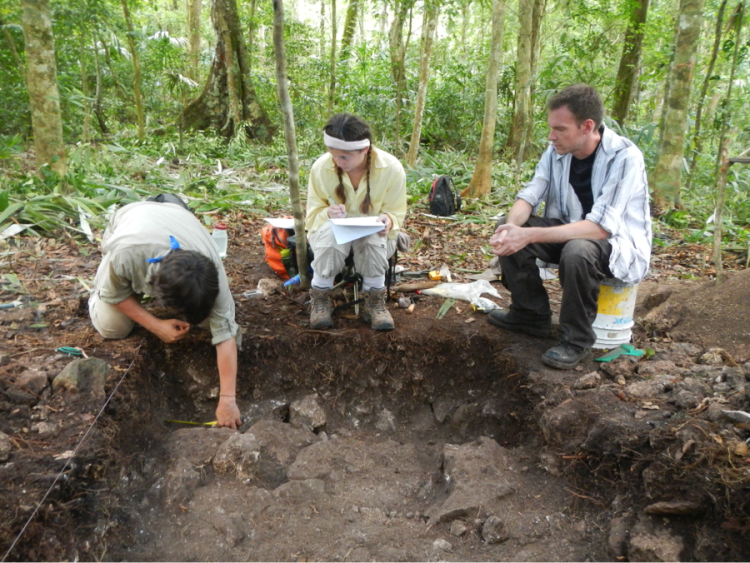By Audrey Cross
Archaeologists… they need help. They excavate sites, hopefully taking really good notes, ask for help from specialists, read, synthesize information, imagine past cultures and landscapes, theorize, question, and hopefully publish their findings. I don’t want to be an archaeologist, but since both of my parents were, it’s a part of me. Maybe without being an archaeologist myself, I can help them, though, because their work is best done with help from different types of specialists.
In the summer of 2012, I did a field school that my mother was running in the Rio Bravo Conservation Area in northwest Belize. My late mother had done work and run field schools there for as long as I’ve been alive, and I was finally getting a sense of what her work meant. Amongst the many facets of this field school that sparked my interest, the study of the nearby bajos got my mind thinking in terms of paleoecology.

Fig. 1. Members of the 2012 Maax Na field crew at Bolsa Verde, excavating a Mayan plaza. Perhaps 30m from the edge of this picture, there is a steep slope downwards towards to the bajo. (Photo by Audrey Cross)
In the past few decades, there has been a shift from studying the Maya elite and temples to studying the experience of average people, which opened doors to the study of ancient Mayan agriculture. Where did the food that fed the civilization come from? What did they eat? How can we look at today’s rainforest landscape to extrapolate into the past?
Many Maya sites, particularly those in the Lowlands, are adjacent to bajos, which are karstic depressions that are seasonally swampy and lower in elevation than the cities. For example, the bajo was less than fifty meters from the ancient Mayan plaza we were excavating (Fig. 1). Through use of aerial / satellite photographs, GIS, surveying & mapping, the Landsat Thematic Mapper, various types of synthetic aperture radar (SAR) and various software and modeling systems (Pope & Dahlin 1989)—quantitative and qualitative—archaeologists have been looking at these bajos, trying to determine their former functions. Much of the literature on bajos and man-made canals in this area has been arguing that bajos were used for agriculture, perhaps to feed the adjacent city (Lentz 1991; Pope & Dahlin 1989).

Fig. 2. Members of the 2012 Maax Na field crew with their recently unearthed metate. The area on this artifact that appears orange in this picture is a shallow depression in the rock, the surface upon which ancient Mayans ground corn. (Photo by Audrey Cross)
Analysis of pollen, charcoal, and macrofossil evidence gleans knowledge about the agricultural practices of the ancient Maya, which in turn glean information about the culture, the systems of valuation, the diets of ancient Mayan people, and more. For example, maize (Zea mays) was and is culturally important to Latin American countries, particularly Mexico, Belize, and Guatemala. At sites throughout Central America, archaeologists have unearthed seeds, pollen, cobs, cupules and kernels of ancient maize, at different concentrations and levels of preservation (Dunning et al. 2002, Lentz 1991, Pope & Dahlin 1989). However, even if macrofossils are lacking or limited in some areas, there can often be archaeological evidence of the presence of corn, such as manos and metates (Fig. 2), which are grinding stones for making flour (Lentz 1991; Harris 1972).
At the site of Copán in western Honduras, carbonized corn kernels were found in three small caches (Fig. 3); the kernels that had been removed from the cob before they were burned, and by analyzing the kernel size and the angle they can estimate what row of the cob they were found on (Lentz 1991). While in isolation, the row number of the kernel doesn’t seem to mean much. However, when the size, shape and row number of these kernels in Honduras are similar to corn kernels found in deposits at sites in Mexico, Honduras, Guatemala, Costa Rica, and Panama (Lentz 1991), then things get tricky. Was there ritual significance for corn kernels from a specific part of the cob? What might these kernels have meant to those who had burned them? Or were they intentionally burned at all, and it’s just a coincidence? Were there other kernels there that didn’t preserve well?
Works Cited:
Dunning, N. P., Luzzadder-beach, S., Beach, T., Jones, J. G., Scarborough, V., & Culbert, T. P. (2002). Arising from the Bajos : The Evolution. Annals of the Association of American Geographers, (February 2014), 37–41.
Harris, D. R. (1972). The Origins of Agriculture in the Tropics: Ecological analysis affords new insights into agricultural origins and suggests a fresh evaluation of the limited archaeological evidence. American Scientist, 60(2), 180–193.
Lentz, D. L. (1991). Society for American Archaeology Maya Diets of the Rich and Poor : Paleoethnobotanical Evidence from Copan MAYA DIETS OF THE RICH AND POOR : PALEOETHNOBOTANICAL EVIDENCE FROM COPAN. Latin American Antiquity, 2(3), 269–287.
Pope, K. O., & Dahlin, B. H. (1989). Ancient Maya Wetland Agriculture : New Insights Ecological. Journal of Field Archaeology, 16(1), 87–106.
Dunning, N. P., Luzzadder-beach, S., Beach, T., Jones, J. G., Scarborough, V., & Culbert, T. P. (2002). Arising from the Bajos : The Evolution. Annals of the Association of American Geographers, (February 2014), 37–41.
Harris, D. R. (1972). The Origins of Agriculture in the Tropics: Ecological analysis affords new insights into agricultural origins and suggests a fresh evaluation of the limited archaeological evidence. American Scientist, 60(2), 180–193.
Lentz, D. L. (1991). Society for American Archaeology Maya Diets of the Rich and Poor : Paleoethnobotanical Evidence from Copan MAYA DIETS OF THE RICH AND POOR : PALEOETHNOBOTANICAL EVIDENCE FROM COPAN. Latin American Antiquity, 2(3), 269–287.
Pope, K. O., & Dahlin, B. H. (1989). Ancient Maya Wetland Agriculture : New Insights Ecological. Journal of Field Archaeology, 16(1), 87–106.
